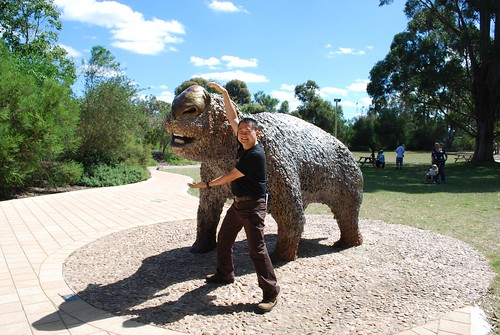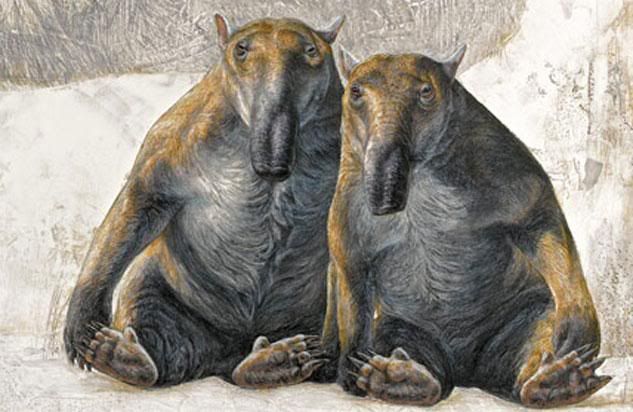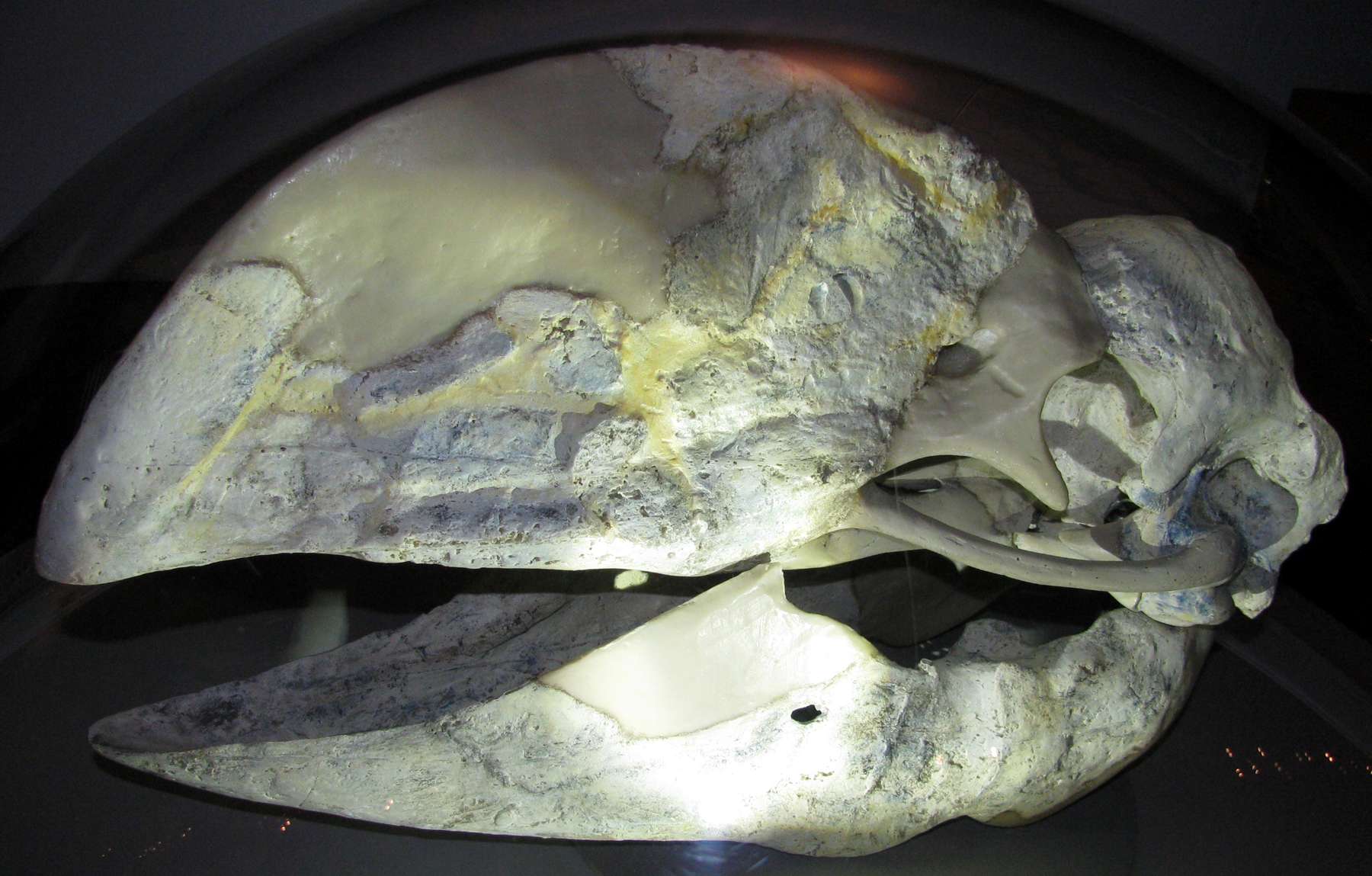It is true that Oz seems to have more than its fair share of bitey and stabby nasties: They have funnel-web and redback spiders, blue-ringed octopus, death adders, tiger snakes and taipans. The most venomous sea snake - Belcher's - lives in the seas around Australia, as do the stone fish and box jellyfish, and even the platypus has venom in its cockspur-like rear claws. But why do they need to carry so much poison?
The answer often suggested is that creatures developed venom to counter the threat posed by predatory creatures that no longer exist - the extinct so-called Australian megafauna. So let's look at that theory for a moment. Firstly, what kinds of creatures were the megafauna?
When I was at school I clearly remember learning all about mammoths, woolly rhinos, mastadons, sabre-toothed cats and other big extinct mammals like brontotherium, giant ground sloths and the staggeringly massive paraceratherium (seen here in comparison with a modern African elephant).

But I don't recall being told about the big animals in the southern hemisphere except, maybe, giant carnivorous birds like the moa and aepyornis.
I was robbed!
Austrailia had some amazing prehistoric giants ... and I am pretty sure that many of you will have never heard of them either. Let me point out a few stars (we'll start small and work up):

Say hello to Zaglossus hacketti. This was an echidna, an egg-laying spiny anteater, the size of a sheep. There was also a type of platypus called Obdurodon dicksoni that was twice the size of its surviving cousin.
The largest fossil marsupial found to date is the mega-wombat Diprotodon optatum that grew to at least three metres long, two metres high at the shoulder and weighed up to two tonnes.
The largest fossil marsupial found to date is the mega-wombat Diprotodon optatum that grew to at least three metres long, two metres high at the shoulder and weighed up to two tonnes.

This whopping great feller below was called Procoptodon goliah, a type of short-faced kangaroo that grew 2–3 metres (7–10 feet) tall, and weighed up to 230 kilograms. Procoptodon has become better known in recent years after the character of Raz appeared in the film Ice Age: Continental Drift.
Related to the kangaroos but quite different in form was the curious-looking Palorchestes azael, a tapir-nosed, heavily clawed creature the size of a cow. You wouldn't want to laugh at it to its face.

Pushing the slider up the dangerous scale we come to Thylacoleo carnifex, the so-called 'marsupial lion', that was the size of a modern leopard. Although totally unrelated, its skull is remarkably cat-like and boasts large slicing pre-molars. It had a retractable thumb-claw and massive forelimbs. It was almost certainly carnivorous and, bizarrely, lived in the trees.

Finally, we come to the real monsters. Top of the Australian food chain was a host of terrifying, large, flightless birds including the largest - Dromornis stirtoni, (Stirton's thunder bird) that stood three metres tall and weighed about 500 kilograms - and my personal favourite, Bullockornis planei, nicknamed the 'Demon Duck of Doom'.
This was a carnivorous, predatory bird related to modern ducks and geese, that had a skull bigger than a horse's. Wow.

The only animals that could compete with the birds were the reptiles, such as the 7 metre (23 feet) long goana lizard Varanus priscus, the 7 metre long crocodile Quinkaka, a genus of land turtle called Meiolania measuring 2.5 metres (8 feet) in length, and a 10 metre long hunting snake called Liasis.
Amazing aren't they? However, no Australian fossil animals are anywhere near as big as the fossil animals found elsewhere. So is it really a strong argument to say that the large number of highly venomous Oz animals evolved because of megafauna?
One competing theory claims that it's actually due to Australia's physical isolation. Any isolated community will develop a unique flora and fauna. So maybe somewhere along the evolutionary time line, the tactical use of venom took precedence over the use of strength and speed. So while animals elsewhere in the world became bigger, stronger and/or faster, Australian animals were developing techniques which allowed them to hunt effectively while remaining small in size.
Another theory claims that it's due to climate. Many Australian venomous animals are cold-blooded and live in desert or grassland areas. They are at the mercy of the continent's frequent droughts; some areas often go months or years without decent rainfall. This means that prey animals become scarce so, if a carnivorous animal misses an opportunity to feed, it may be the last chance they ever have (even though many cold-blooded animals can live for long periods between meals). By using venom that quite often contains paralysing toxins, the hunter will usually only need to get one good bite or sting to fell its prey. Consequently, the energy spent on producing venom is economically well-spent.
We should also consider the fact that referring to these animals as 'highly venomous' is somewhat anthropocentric. While their venom can kill us or make us very ill, it often has a much less potent effect on other species that have evolved alongside them in the same ecosystem. Humans have only been on Australian soil for a short blip of geological history after all.
So it seems, after some research, that there's no single definite answer to the question but plenty of sensible, well-argued possible answers. It's probably a combination of several factors, including the megafauna.
As for me? I just wish the Demon Duck of Doom were still around.




Personally I'm inclined to believe it's a mix, the need to be accurate in prey hunting, the isolation and the conservation of energy whilst hunting. Everything tried to eat me when I went to Sydney but I was a good target, large - slow moving - and normally unaware of something trying to eat me until someone swatted it off me.
ReplyDeleteI have just today read that they've recently found the largest platypus fossil ever. It was big and bitey and could crush turtles with its teeth. Pretty awesome! http://www.theaustralian.com.au/higher-education/giant-platypus-a-fearsome-predator-palaentologists/story-e6frgcjx-1226753046233
ReplyDeleteI have a question in a similar vein (at least, I hope it's in a similar vein).
ReplyDeleteWhy does the plant kingdom produce so many substances that are medicinally useful? Is it just a coincidence?
(I'd guess that there's some sort of explanation that has to do with evolution, but I've no idea what it might be.)